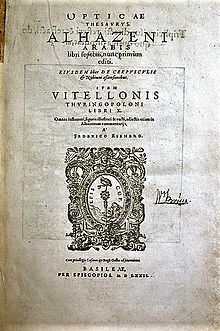Book of Optics

Cover page for Ibn al-Haytham's Book of Optics
|
|
| Author | Ibn al-Haytham |
|---|---|
| Original title | كتاب المناظر |
| Language | Arabic |
The Book of Optics (Arabic: Kitāb al-Manāẓir (كتاب المناظر); Latin: De Aspectibus or Perspectiva; Italian: Deli Aspecti) is a seven-volume treatise on optics and other fields of study composed by the medieval Arab scholar Ibn al-Haytham, known in the West as Alhazen or Alhacen (965– c. 1040 AD).
The Book of Optics presented experimentally founded arguments against the widely held extramission theory of vision (as held by Euclid in his Optica) and in favor of intromission theory, as supported by thinkers such as Aristotle, the now accepted model that vision takes place by light entering the eye. Alhazen's work extensively affected the development of optics in Europe between 1260 and 1650.
Before the Book of Optics was written, two theories of vision existed. The extramission or emission theory was forwarded by the mathematicians Euclid and Ptolemy, who asserted that certain forms of radiation are emitted from the eyes onto the object which is being seen. When these rays reached the object they allowed the viewer to perceive its color, shape and size. The intromission theory, held by the followers of Aristotle and Galen, argued that sight was caused by agents, which were transmitted to the eyes from either the object or from its surroundings.
Al-Haytham offered many reasons against the extramission theory, pointing to the fact that eyes can be damaged by looking directly at bright lights, such as the sun. He claimed the low probability that the eye can fill the entirety of space as soon as the eyelids are opened as an observer looks up into the night sky. Using the intromission theory as a foundation, he formed his own theory that an object emits rays of light from every point on its surface which then travel in all directions, thereby allowing some light into a viewer's eyes. According to this theory, the object being viewed is considered to be a compilation of an infinite amount of points, from which rays of light are projected.
...
Wikipedia
